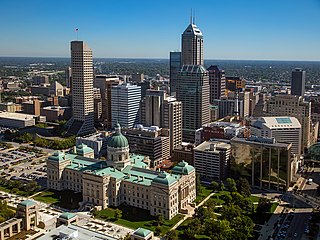
Downtown Indianapolis is a neighborhood area and the central business district of Indianapolis, Indiana, United States. Downtown is bordered by Interstate 65, Interstate 70, and the White River, and is situated near the geographic center of Marion County. Downtown has grown from the original 1821 town plat—often referred to as the Mile Square—to encompass a broader geographic area of central Indianapolis, containing several smaller historic neighborhoods.

The history of Indianapolis spans three centuries. Founded in 1820, the area where the city now stands was originally home to the Lenape. In 1821, a small settlement on the west fork of the White River at the mouth of Fall Creek became the county seat of Marion County, and the state capital of Indiana, effective January 1, 1825. Initially the availability of federal lands for purchase in central Indiana made it attractive to the new settlement; the first European Americans to permanently settle in the area arrived around 1819 or early 1820. In its early years, most of the new arrivals to Indianapolis were Europeans and Americans with European ancestry, but later the city attracted other ethnic groups. The city's growth was encouraged by its geographic location, 2 miles (3.2 km) northwest of the state's geographic center. In addition to its designation as a seat of government, Indianapolis's flat, fertile soil, and central location within Indiana and the Midwest, helped it become an early agricultural center. Its proximity to the White River, which provided power for the town's early mills in the 1820s and 1830s, and the arrival of the railroads, beginning in 1847, established Indianapolis as a manufacturing hub and a transportation center for freight and passenger service. An expanding network of roads, beginning with the early National Road and the Michigan Road, among other routes, connected Indianapolis to other major cities.

St. Michael's Catholic Church is a historic Catholic church in Mechanicsburg, a village in Champaign County, Ohio, United States. Completed in the 1880s, it served a group of Catholics who had already been meeting together for nearly thirty years. One of several historic churches in the village, it has been designated a historic site because of its well-preserved nineteenth-century architecture.

The Thomas A. Hendricks Monument is a public artwork by American artist Richard Henry Park and is located on the southeast corner of the Indiana Statehouse grounds in Indianapolis, Indiana. The monument is a tribute to Thomas A. Hendricks, the 21st Vice President of the United States. Hendricks was a former U.S. Representative and U.S. Senator from Indiana. He was the 16th Governor of Indiana and led the campaign to build the Indiana Statehouse.
Robert Dale Owen Memorial is a public artwork located at the south entrance of the Indiana Statehouse along Washington Street in Indianapolis, Indiana. The memorial was donated to the state of Indiana and dedicated in 1911 in honor of the Indiana politician, Robert Dale Owen (1807–1877). The bronze portrait bust by Indiana sculptor, Frances M. Goodwin, has been missing from this memorial since 1970. The memorial's remaining pedestal is made from three stone blocks and includes a commemorative plaque.
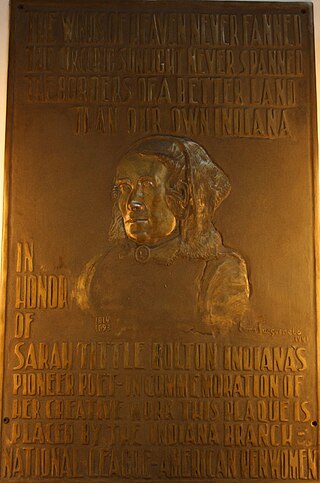
Sarah T. Bolton is a public artwork by American artist Emma Sangernebo (1877–1969). It is located on the second floor of the rotunda in the Indiana State House, Indianapolis, Indiana, United States. It is a bronze sculptural relief of Indiana poet Sarah Tittle Bolton, née Barrett and contains four lines from Bolton's poem "Indiana".

Frances Elizabeth Willard is a public artwork designed by American artist Lorado Taft, located in the rotunda of the Indiana State House, in Indianapolis, Indiana, United States. It is a bronze plaque, given by the Women's Christian Temperance Union, commemorating the fiftieth anniversary of Frances Elizabeth Willard's election as President of the WCTU.

Stephen Neal is a public artwork by Indiana artist Clara Barth Leonard. It is located in the Indiana Statehouse, which is in Indianapolis, Indiana, United States. The subject of the work is Stephen Neal, a member of the Indiana State Legislature and a Judge of the Boone County Circuit Court during the mid-to-late-19th century, as well as being the author of the original draft of the Fourteenth Amendment to the United States Constitution. The bronze bust is located on the second floor of the Indiana Statehouse in a waist-high limestone niche, and faces west towards North Senate Avenue.

Benjamin Harrison is a bust by American artist Richard Peglow, located in the north atrium on the second floor of the Indiana Statehouse in Indianapolis, Indiana, United States. The bust is cast in bronze and depicts President Benjamin Harrison. The bust is placed in front of a grey and black marble shield with six stars tracing around the edge of the shape. The bust and shield are approximately 28 inches (710 mm) wide by 25 inches (640 mm) high and has a depth of 14.5 inches (370 mm). The artwork was cast and placed in the statehouse in 2008 in accordance with Indiana code Section 2. IC 4-20.5-6-12.

Christopher Columbus is a public artwork by Italian artist Enrico Vittori and located on the grounds of the Indiana Statehouse in Indianapolis, Indiana. The sculpture was installed on the southwest corner of the Indiana Statehouse lawn in 1920 as a gift from Italian immigrant communities in Indiana.
Calvin Fletcher is a public artwork by an unknown artist, located inside the Indiana Statehouse in Indianapolis, Indiana, United States. The marble bust depicts Calvin Fletcher (1798–1866), a man who settled in Indiana early in the state's history and went on to become an attorney and senator. The bust stands 47.5 inches high, has a width of 20 inches and a depth of 10.25 inches.

The Abraham Lincoln commemorative plaque is a work of public art designed by Marie Stewart in 1906, created by Rudolph Schwarz, and dedicated on 12 February 1907.

George Rogers Clark is a plaster bust made by American artist David McLary. Dated 1985, the sculpture depicts American Revolutionary War hero and frontiersman George Rogers Clark. The bust is located in an alcove on the third floor of the Indiana Statehouse in Indianapolis, United States. The bust measures 32 inches (81 cm) by 20 inches (51 cm) by 15 inches (38 cm) and sets upon a wooden base measuring approximately 6 inches (15 cm) by 19 inches (48 cm) by 24.25 inches (61.6 cm).

Matthew E. Welsh is a public artwork by American artist Daniel Edwards. It is located on the third floor of the Indiana State House, which is in Indianapolis, Indiana, United States. The bronze bust depicts Matthew E. Welsh, the 41st governor of Indiana (1961–1965). The bust measures 23.5 x 12.75 x 12 inches and has a wooden base which measures 4 x 14.75 x 10.5 inches. In 1996, one year after Welsh's death, the Indianapolis law firm of Bingham, Summers, Welsh & Spilman commissioned artist Daniel Edwards to sculpt the bust of Welsh. The bust was dedicated in a ceremony at the Indiana Statehouse on December 20, 1996.

Oliver P. Morton and Reliefs is a public artwork by Austrian artist Rudolph Schwarz, located on the east side of the Indiana Statehouse in Indianapolis, Indiana, at the intersection of North Capitol Avenue and West Market Street.
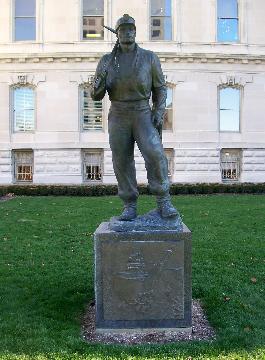
Coal Miner is a public artwork by Polish American artist John J. Szaton (1907–1966) which is located in two US State capitals; the original, commissioned in 1963 in Springfield, Illinois, as well as a copy on the west lawn of the Indiana State House in Indianapolis The statues commemorate coal miners who had lost their lives in those states' mining industry. The 7-foot (2.1 m) tall statue rests on a 3-foot (0.91 m) square, granite base supported by a cement foundation that is 4–6 inches (100–150 mm) thick.
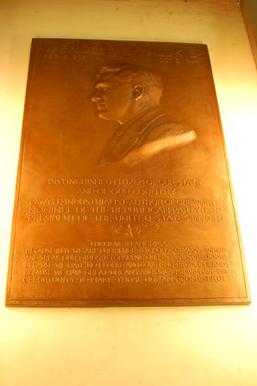
Wendell Willkie plaque is a public sculpture at the Indiana Statehouse in Indianapolis, Indiana, and was designed by American sculptor and educator Paul Fjelde. This bronze plaque honors Wendell L. Willkie (1892–1944) who was the Republican Party nominee for the U.S. presidency in 1940. The plaque was placed in the Statehouse rotunda on February 18, 1950. The inscription on the bottom of the plaque was taken from Willkie's book "One World" which calls for unified world order.

The bust of Sherman Minton is a public artwork by American artist Robert Merrell Gage, located on the main floor of the Indiana Statehouse, which is in Indianapolis, Indiana, United States. Cast in bronze in 1956, it was commissioned to honor politician — a United States senator from Indiana and later an Associate Justice of the Supreme Court of the United States.— and Indiana native Sherman Minton.

Roberts Park Methodist Episcopal Church, whose present-day name is Roberts Park United Methodist Church, was dedicated on August 27, 1876, making it one of the oldest church remaining in downtown Indianapolis. Diedrich A. Bohlen, a German-born architect who immigrated to Indianapolis in the 1850s, designed this early example of Romanesque Revival architecture. The church is considered one of Bohlen's major works. Constructed of Indiana limestone at Delaware and Vermont Streets, it has a rectangular plan and includes a bell tower on the southwest corner. The church is known for its interior woodwork, especially a pair of black-walnut staircases leading to galleries (balconies) surrounding the interior of three sides of its large sanctuary. The church was added to the National Register of Historic Places on August 19, 1982. It is home to one of several Homeless Jesus statues around the world, this one located behind the church on Alabama Street.
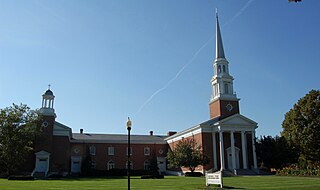
Meridian Street United Methodist Church, known in its early years as Wesley Chapel, the Meridian Street Methodist Episcopal Church, and the Meridian Street Methodist Church, is a Methodist church located at 5500 North Meridian Street in Indianapolis, Indiana. The church originated from the first Methodist congregation in Indianapolis that began in a log cabin in 1821–22 with fifty members. The congregation worshipped at several locations and erected four earlier churches on Monument Circle and along Meridian Street in downtown Indianapolis before it merged with the Fifty-first Street Methodists in 1945. The first service at its North Meridian Street location was held on June 29, 1952. Designed by the architectural firm of Russ and Harrison, the Georgian-Colonial-style, red-brick church is noted for its architecture, pipe organ, and formal parlor. The Aldersgate addition on the west side (rear) of the church was consecrated on October 4, 1989.















